| Islamic Culture Forum 5- 28 February 1976-Islamic Culture Society (JAPAN) |
| the Tokyo Mosque |
| p17-24 |
|
| ITS HISTORY AND ITS ROLE IN THE ISLAMIC CALL MOVEMENT IN JAPAN |
|
Some of our readers have expressed surprise knowing for the first time thatthere are Muslims in Japan and that there are also mosques in this country・
Perhaps this surprise originates from the fact that although Japan is very
we11-known as an economically advanced country to the people of the world,its spiritual
image among them is apparently one of non-lslamic,even anti' lslamic.
ln the past, Japan had a very thin or no relation at all with lslam. Until
about seventy years ago most of the Japanese did not have any clear idea
of the existence of a religion called lslam.0nly recently that many of
them came to know about the lslamic world. And the oil crisis gave them
the opportunity to know quite wen that a large number of the people of
Asia and Africa are believers of lslam because the shock came mainly from
the Middle Eastem Muslim countries from where Japan must have most of its
on requirements.Yet, though the Japanese people have shown great interest
in the oil producing Muslim countries, their lands and their People,very
few have shown any interestin these people's religion−lslam. At the same
time, the number of the Japanese Muslims is so negligible that they are
also not in a position to exert them selves and impress upon their non-Muslim
compatriots so far as the religion of lslam is concerned.
For instance, the oldest organization of the Japanese Muslims, Japan Muslim
Association,which has a history of 24 years,has a regular Japanese Muslim
membership of not more than one hundred.lt is quite likely that for various
reasons hundreds of other Japanese Muslims have not enrolled themselves as
members of Japan Muslim Association. ln any case, it is true that its membership
has not increased upto the extent as one could expect of it for a period
of 24 years.
However,in spite of such unfavour able circumstances,we can see that a
Pioneer Japanese Muslim,Mitsutaro Yamaoka, Performed Hajj and became the first among
the Japanese Muslims to do so as early as in 1909. From 1920 until today,
at least six Japanese translations of the Holy Quran were published,among
them, the one rendered by Haji Umar Mita is the only one by・a Muslim scholar,and the
rest by non-Muslims. Thus,it can be said that at least several hundred thousand Japanese have had
the opportunity to read the meaning of the Holy Quran although not all
of the translations can claim accuracy or genumeness.
Before World War II, many organizations sprang up for the purpose of study and
research on lslam. 0ne such organization was “Dai-Nippon Kaikyo Kyokai"
(Japan lslamic Association),supported by the then Japanese Govemment with
Prime Minister General Senjuro Hayashi (1876〜1943) as its President. But
almost all of them were organized by non-Muslim scholars or people interested
only in its cultural study.None of them, thus,could be called a part of
lslamic call movement by any means. But there were also a few lslamic establishments
meant for the religious activities of the Muslims. Among them were the
Kobe Mosque established in 1935, the Tokyo Mosque in 1938 and another small
place of worship in Nagoya city about the same time.However,since then
nearly forty years have passed and during this long Period great many Japanese
came in contact with the Muslims or acquaintcd with lslam. Yet the number
of Muslims has not increased remarkably.Why? What were the difficulties
that stood in the way of spreading lslam in this country?
To answer this question, l want to have close look into the situation some
forty years ago when the Tokyo Mosque and other mosques were built, and
into the role of the Tokyo Mosque, in particular,in spreading lslam in
Japan・
At Present,the Tokyo Mosque is situated in the Oyama quarters of Shibuya
Ward of Tokyo. lt was first opened for prayer on 12 May 1938 which was
also the Prophet's Birthday.0n that auspicious day of the opening ceremony,apart
from the foreign Muslim residents.of Tokyo, Muslim guests from various
parts of the world including China,Southeast Asia,lndia,Middle East and
others also attended the ceremony on invitation.Among the distinguished
guests were Amir Saiful lslam AI-Hussein, the fourth prince of the Kingdom
of Yemen attended,representing the lmam of Yemen accompanied by Foreign
Minister Hussein Al-Gibsi and Hodeida Governor Qadi Ali Al-Hussein Al-Amri;
Sheikh Hanz Wahaba,Minister at the Saudi Arabian Embassy in the united
Kingdom,representing the King of Saudi Arabia; and Abdul Wahhab Dawood
Bey, Minister at the Egyptian Embassy in Tokyo, representing the King of
EgyPt .and many others from a number of Muslim countries.
|
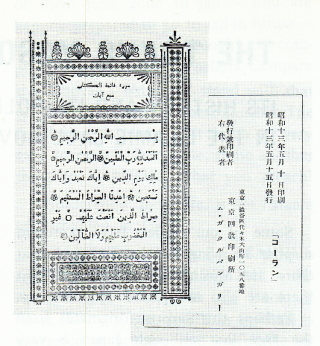 |
| Holy Quran, first printed in Japan (1938) |
From the Japanese side,Patriotic political leaders like Mitsuru Toyama
and General lwane Matsui, the Minister of Education and many other influential
personalities attended the opening ceremony of the Tokyo Mosque. From the
grandeur of the ceremony through the participation of so many Japanese
and foreign dignitaries, it appeared as if a strong lslamic movement is
going to take place in Japan.
The fund that was made avaUable for the construction of the Tokyo Mosque amounted to about 120-thousand in the old Japanese yen currency the
present valuation of which could be equivalent to nearly 800-thousand US dollars.lf looked from the present-day circumstances of the Japanese Muslims,this is an unimaginably large amount.
Unfortunately, however,the worldwide connagration of the Second Great War and its end throughthe defeat of Japan, in effect, destroyed what appeared to be the start of a strong lslamic movement in this country. All the institutions and organizations which had hitherto been making efforts for the study of lslam or supporting the Tokyo
Mosque,were disbanded because they were sponsored or supported by the pre-War Japanese Govemment or the Japanese Military authorities throouth providing finance or leadership.
ln spite of all the twists and turns,since about seventy years ago,lslam
made its way into Japan, though in a very slow pace, and the People started
to know about lslam little by little through the translations of the life
of Prophet Muhammad(SAW)as well as the Holy Quran which found their way
along the Westem culture. Thus,lslam was introduced in Japan not as a religious
belief for the Japanese People, rather as a socio-cultural study. So its
diffusion was not possible as a religious belief.
Perhaps it was from around 1920 that lslam became a practiced religion
in Japan by both the foreign and the Japanese Muslims when a group of Mus1ims
of Tartar Turk origin migrated from the USSR to Japan in the wake of the
Bolshevik Revolution in Russia, and settled in Japan. The Japanese Government
which was strongly anti-Communist-showed great sympathy for these uprooted
Russian Muslims, numbering about 600,and helped most of them to settle
in this country under its protection. Among them, about 400 settled in
Japan mainly in Tokyo,Kansai and Nagoya areas and made their living mainly
on peddling woolen cloth. At the same time,they were the first people who
established the lslamic life in this non-lslamic land. ln other words,
lslamic religious life started in Japan with the immigration of these Tartar
Turk refugees from Russia and with this started the intercourse between
the local Japanese people and lslam, though in a very insignincant scale.
After their settlement in Japan, these Muslims needed to make contacts
with the Japanese Govemment as well as with various other politica1,economic
or social cirdes for the purpose of improving their situation, Fortunately,
they were blessed at that time with a very resourceful leader in the person
of the late Muhammad Abdu1 Hai Kurban Ali.
Son of a Bashikirit lmam,Kurban Ali was born in 1890 in Orenburg,eastem Russia. He came in contact with the Japanese Army in Manchuria when he was fleeing from the Soviet Russia along with other Tartar Muslims. There he earned sympathy of the Japanese Army. ln 1920, when he came to Japan,he was provided with a job of teaching Turkish and Russian at the General Staff Headquarters of the Japanese Army.
|
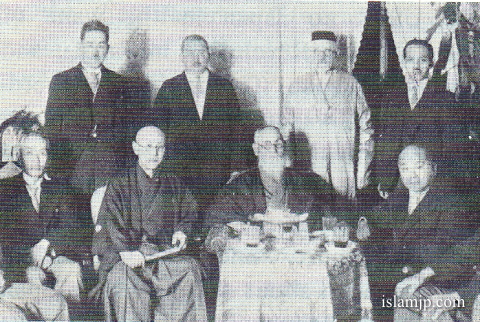 |
Late Kurban Ali with Mitsuru Toyama and other eminent Japanese
(standing second from left)
|
Kurban Ali was a man of great political and diplomatic acumen and possessed
other statesmanlike qualities. He was also sociable and personable,the
qualities which could influence people. With the help of all these qualities
and by dint of untiring zeal and efforts as well as his convincing arguments,he
impressed upon the Japanese Government,politica1, economic and military
leaders,like Mitsuru Toyama (1855−1944),Tsuyoki lnugai (1855−1932),Shigenobu
Okuma(1838−1922),Chosei Ogasawara,Tokijiro Jitsukawa and so on,about the necessity of
Japan's having strong ties with the Muslims of the world,By his convincing
advocacy, many influential Japanese became sympathetic toward the lslamic cause,though in
political sense, and Kurban Ali earned their material and moral support for
lslamic activities.Thus,in 1931,with their help and support an office of
theTurkish Muslims was established in Tomigaya in Shibuya Ward of Tokyo,
not very far from the Present location of the Tokyo Mosque.
ln this office premises, educational facities for the Tartar Turk children
and an Arabic printing press were estab1ished. From this press,Kurban Ali
Published a monthly magazine called Yane Yapon in the Tartar language.
ln 1938, an Arabic Print of the Holy Quran was brought out from this Press
for the first time in Japan. Through the Yane Yapon Mokhbiri he succeeded
in drawing attention of People from various parts of the world. Thus,the
magazine played an important role in establishing goodwill and understanding
between its readers abroad and the Japanese People. As a result, it also
earned high esteem and sympathy of many leading personalities in the Japanese
politica1, economic and military circles. And also,just this was the time
when the Japanese militalism was at its peak and when Japan was trying
to establish a policy of cooperation and rapport toward the Muslim countries. |
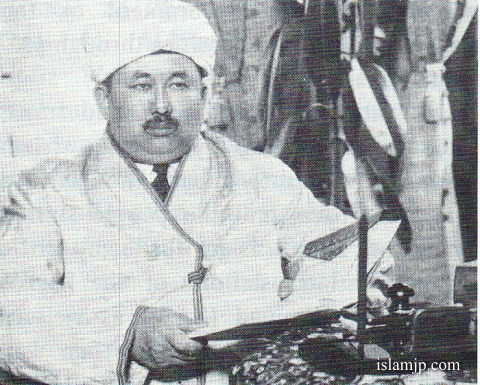 |
| Late Kurban Ali |
Kurban Ali had a long cherished desire for building a mosque in Tokyo.
With the help and support from various Japanese Patrons, he at last succeeded
in collecting necessary funds for the land and building of a mosque. A
top shipping magnet of those days, Kamesaburo Yamashita(1867−1944),donated 1,655m2 of
his own land for the site of the Planned mosque. For the expenses of construction,
the then Mitsubishi Bank President Kiyoshi Seshimo personally donated 20'thousand
Pre War Japanese yen. EnterPrises such as Mitsui,Mitsubishi,Sumitomo and
many others also made contribution. The total sum thus collected,as mentioned earlier,amounted to about 120
thousand Pre-War Japanese yen (the Present valuation may amount to about
800 thousand US dollars). The whole amount was handed over to Kurban Ali
to meet the cost of construction of the mosque bulding. ln October 1937,
Kurban Ali initiated the construction designed by architect Yoshimoto and
operated by the Morota Construction company. The building was completed、in
May 1938. This is what the present-day Tokyo Mosque situated in the Oyama
quarters of Shibuya Ward in Tokyo.
As the leader of the Tartar Turk immigrants and also of the Muslims in
genera1,Kurban Ali left many achjevements to his credit. 0n the other hand,because
of his uncompromising attitude and strongly individualistic manner in the
face of any interference, there also occurred some serious troubles involving
him. 0ne such example is his confict with Ayas lshaq,a Prominent leader
of the Tartar National Movement, who visited Japan in 1933. 1n another
example,althoug he did not have any frontal conflict with lmam lbrahim
Bey,the Grand Mufti of Tartar, who came to Japan on a second visit (first
visit in the turn of the century)sponsored by the Turkish Embassy in Tokyo,Kurban
Ali did not find it opportune to cooperate with him, either. When the construction of
the Mosque was making rapid Progress toward completion,a fierce controversy
arouse on the question who will become the lmam of the Tokyo Mosque. The situation
developed into so serious proportion that,out of political expediency,
the Japanese Government intervened. The result was that Kurban Ali was
deported to Dairen (Lu-Ta),Manchuria. Thus,the man who
was the driving force behind the building of the Tokyo Mosque could not
even attend its opening ceremony. He had also to leave his family in Tokyo
never to meet them again. After World War ll, the Soviets took him as a
Prisoner. ln 1972,Kurban Ali breathed his last in Chelyabinsk,Soviet union.He
was then 82. |
 |
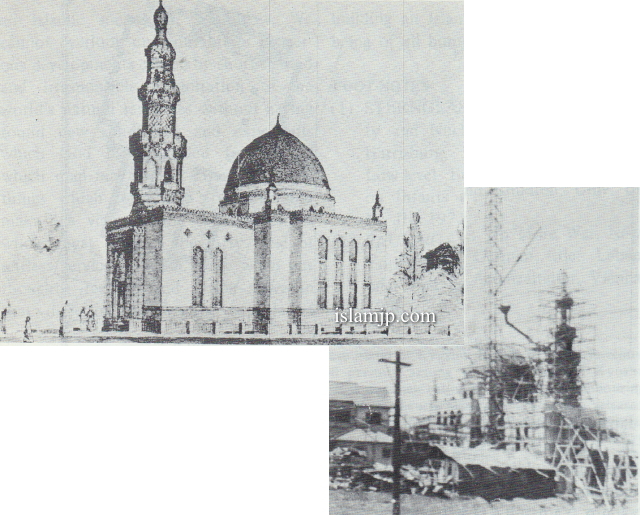 |
Tokyo Mosque: Designers drawing, showing completion,
Under constraction |
When World War ll came to an end,a greater part of Tokyo was in ruins
due to air raids. Fortunately,the Tokyo Mosque escaped destruction or damage.
But the conditions surrounding lslam or the Tokyo Mosque drastically changed.
After Japan's defeat in the War,all kinds of organizations associated with
the defunct lmperial Japanese military were disbanded or reorganized appropriate
to the new situation. So was the fate of the organizations which were patronized
by the military for the study of lslamic culture. The New Law of Japan
did not permit the Japanese Government to suport any particular religious
group or to help diffuse religious education as a faith in the government
institutions. As a result,all sorts of lslamic activities have had to dependsolely
upon private support of only the Muslims within and without Japan. The
Tokyo Mosque came to be maintained by the Turkish community living in Japan.
However,even after the War,the Tokyo Mosque continued to be mainly a
place of worship for only those who are already Muslims. ln the Post-War
years,when many countries with pre-dominately Muslim population became
independent and have had ties with Japan, an increasing number of foreign
Muslims both for Private or official visits started coming to Japan, and
the Tokyo |
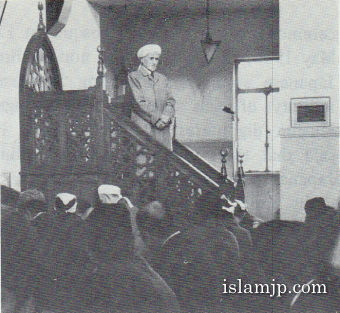 |
| Tokyo Mosque: lmam Ainan Safa on the minbar, |
There should not be any language controversy involving a Baitullah.
There is also not a single Muslim to raise any question regarding using
Arabic in the Salat. But the Khutba given by the Khatib must be understood
by all the worshippers present. Specially,the Japanese who generally do not speak or
understand a foreign language will extremely welcome the use of Japanese
for Khutba and other deliberations in the Mosque.
Another point is that the Tokyo Mosque’s role also as the Pivot of the
lslamic call movement among the Japanese people must be stressed. Because
the call movement is aimed at the Japanese,they must also have a feeling
of Participation in all the functions of the Tokyo Mosque instead of merely
playing the role of onlooker. Unfortunately,there has not been any scope
for a feeling of participation among the Japanese Muslims for various reasons.
Before the War when the Japanese Government and others supported the establishment of
the Tokyo Mosque,they did it for political expediency and meant it for the foreign
Muslims. They had nothjng do with the diffusion of lslamic education or spreading lslam in this
country. ln fact, one cannot expect of them any such purpose other than
expediency. And as a natural corollary,no one could expect much of the
Tokyo Mosque playing a vital role in the lslamic call movement in addition
to its Providing a place of worship for the Mus1ims,mostly foreign in those
days. lt is interesting to note that in the opening ceremony of the Tokyo
Mosque on 12 May 1938,a large number of non-Mushm Japanese supporters including
Japanese military officials together with foreign Muslim dignitaries attended,but
it is said that there was not a single Muslim Japanese attending. ln sum,the use of the Japanese
language in the Tokyo Mosque, in the situations where it can be or should
be used、will raise a sense of participation among the Japanese and, in
effect,it will he1p strengthening the lslamic call movement in this country.
0n the part of the Japanese Muslims, they must also play their own responsible
role in creating a favourable atmosphere for the lslamic call movement
in their country to bund a line of generations of Mulsims. lt is a fact
that they did not perform their duties in the past properly, neither are
they performing them in the present days. Throwing out any kinds of passiveness,they
must come forward and work in a positive manner for the cause in cooperation
with their other brethren. 0nly as a result of their own efforts we can
look forward to the day when a Khutba will be given also in Japanese also
by a Japanese lmam.
The wooden and concrete structure of the Tokyo Mosque is now experiencing
the wear and tear of time. And now is the time to make efforts to build
a new modern structure with more congenial atmosphere pervading the Mosque
as well with better facilities so that it can play its desired role not
only as mere a place of worship but also as the centre of lslamic call
movement in Japan. |
| |
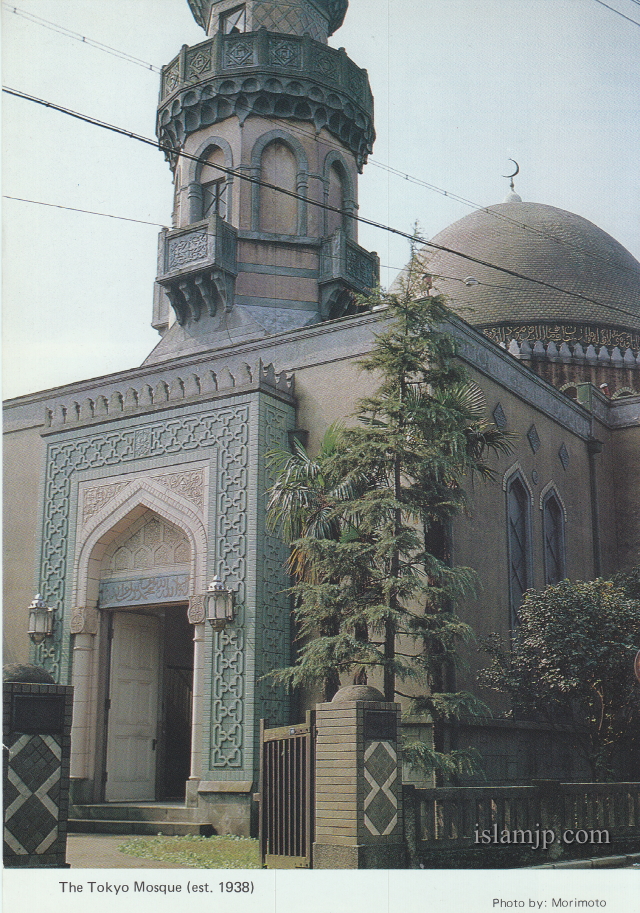 |